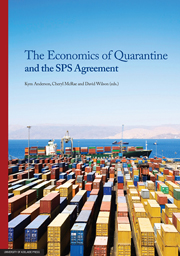Book contents
- Frontmatter
- Contents
- List of tables, figures and boxes
- Acronyms
- Preface
- List of contributors
- 1 Introduction
- PART I The multilateral rules under WTO
- 2 The integration of economics into SPS risk management policies: issues and challenges
- 3 The analytical foundation of quarantine risk analysis
- 4 The WTO dispute settlement framework and operation
- 5 Implications of recent SPS dispute settlement cases
- PART II The ‘appropriate level of protection’
- PART III Adding more economics to risk analysis
- PART IV Specific health and environmental risks from trade
- PART V Conclusion
- APPENDIX The legal text of the SPS Agreement
4 - The WTO dispute settlement framework and operation
from PART I - The multilateral rules under WTO
Published online by Cambridge University Press: 05 June 2013
- Frontmatter
- Contents
- List of tables, figures and boxes
- Acronyms
- Preface
- List of contributors
- 1 Introduction
- PART I The multilateral rules under WTO
- 2 The integration of economics into SPS risk management policies: issues and challenges
- 3 The analytical foundation of quarantine risk analysis
- 4 The WTO dispute settlement framework and operation
- 5 Implications of recent SPS dispute settlement cases
- PART II The ‘appropriate level of protection’
- PART III Adding more economics to risk analysis
- PART IV Specific health and environmental risks from trade
- PART V Conclusion
- APPENDIX The legal text of the SPS Agreement
Summary
The member countries of the World Trade Organization (WTO) have designed a set of rules governing international trade. The rules are legally binding on members and were designed to regulate and expand trade. The dispute resolution system is central to encouraging, facilitating and ensuring compliance with these rules. The rule-oriented system favours mutually agreed solutions and is designed to secure voluntary compliance with removal of inconsistent trade actions. The procedures are detailed and of a quasi-judicial nature. They include timetables, an appeal process, and follow-up to ensure implementation. The system permits little scope for economic considerations.
The first section of this chapter briefly describes the WTO dispute settlement process. The second section outlines how it has been used in three specific disputes concerning the Agreement on the Application of Sanitary and Phytosanitary Measures (the SPS Agreement), and the outcome of those disputes. The final section contains some reflections on the extent economic factors are or are not taken into consideration in the dispute settlement process.
The dispute settlement process
The primary emphasis in the WTO dispute settlement system is to find a mutually satisfactory solution. The first step in the formal dispute settlement procedure is that the complaining Member Country formally requests consultations with the disputed Member through the WTO Dispute Settlement Body. This step is mandatory even though the parties to the trade dispute may have already gone through extensive bilateral attempts to solve the problem.
- Type
- Chapter
- Information
- The Economics of Quarantine and the SPS Agreement , pp. 53 - 74Publisher: The University of Adelaide PressPrint publication year: 2012



